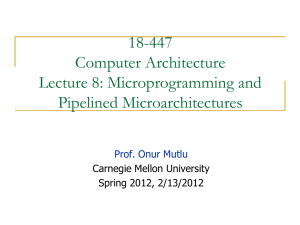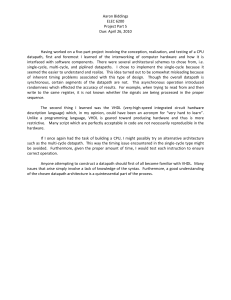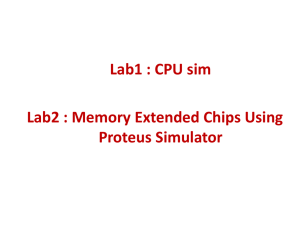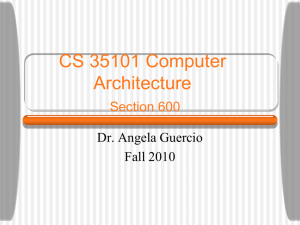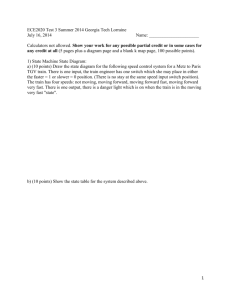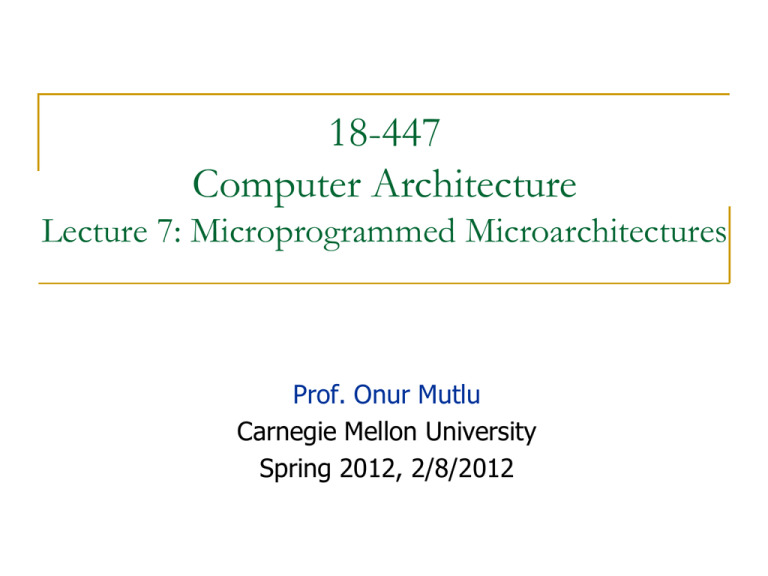
18-447
Computer Architecture
Lecture 7: Microprogrammed Microarchitectures
Prof. Onur Mutlu
Carnegie Mellon University
Spring 2012, 2/8/2012
Reminder: Homeworks
Homework 1
Grades out on Blackboard
Homeworks will be handed out next class
Homework 2
Due February 13
ISA concepts, ISA vs. microarchitecture, microcoded machines
2
Lab Assignment 1
Graded
Your grade is in your handin directory: grade.txt
Test cases will be released
3
Lab 1 Grade Distribution
18
Number of Students
16
14
12
10
8
6
4
2
0
0
100
150
200
250
300
350
400
450
500
550
555
Lab 1 Grade
Average
Median
Max
Min
457
493
555
0
Max Possible Score
Total number of students
555
55
4
Lab 1 Simulation Time
5
Aside: Simulator Design
Accuracy
Functional accuracy: Does the simulator accurately model
what the ISA specifies
Timing accuracy: Does the (timing) simulator accurately model
how many cycles the hardware design would actually take
Speed
6
Reminder: Lab Assignment 2
Lab Assignment 1.5
Verilog practice
Not to be turned in
Lab Assignment 2
Due Friday, Feb 17, at the end of the lab
Individual assignment
No collaboration; please respect the honor code
7
Reminder: Extra Credit for Lab Assignment 2
Complete your normal (single-cycle) implementation first,
and get it checked off in lab.
Then, implement the MIPS core using a microcoded
approach similar to what we are discussing in class.
We are not specifying any particular details of the
microcode format or the microarchitecture; you should be
creative.
For the extra credit, the microcoded implementation should
execute the same programs that your ordinary
implementation does, and you should demo it by the
normal lab deadline.
8
Readings for Today
P&P, Revised Appendix C
P&H, Appendix D
Microarchitecture of the LC-3b
Appendix A (LC-3b ISA) will be useful in following this
Mapping Control to Hardware
Optional
Maurice Wilkes, “The Best Way to Design an Automatic
Calculating Machine,” Manchester Univ. Computer Inaugural
Conf., 1951.
9
Readings for Next Lecture
Pipelining
P&H Chapter 4.5-4.8
10
Oracle/Sun UltraSPARC T4 Talk Today!
Dr. Jared Smolens, PhD CMU 2007
4-5pm
CIC 4th Floor Panther Hollow conference room
T4: A highly-threaded server-on-a-chip with native support
for heterogeneous computing
http://www.ece.cmu.edu/~calcm/doku.php?id=seminars:se
minar_12_02_08
Microarchitecture of Oracle’s newest processor
8 cores, 8 hardware threads in each core
Out-of-order execution
Shared L3 cache; private L1 and L2 caches
Two memory controllers
11
Review: Last Lecture
Finished single-cycle microarchitectures
Microarchitecture design principles
Basic performance evaluation (execution time equation)
What does it mean to design for the common case (or
bread and butter design)?
If memory takes 90% of execution time …
How does the single cycle microarchitecture make “critical
path design” difficult?
Remember the performance equation that consists of three
components… How can you improve each component in a
multi-cycle microarchitecture?
12
Review: Microarchitecture Design Principles
Critical path design
Find the maximum combinational logic delay and decrease it
Bread and butter (common case) design
Spend time and resources on where it matters
Common case vs. uncommon case
Balanced design
i.e., improve what the machine is really designed to do
Balance instruction/data flow through hardware components
Balance the hardware needed to accomplish the work
How does a single-cycle microarchitecture fare in light of
these principles?
13
Review: Multi-Cycle Microarchitectures
Goal: Let each instruction take (close to) only as much time
it really needs
Idea
Determine clock cycle time independently of instruction
processing time
Each instruction takes as many clock cycles as it needs to take
Multiple state transitions per instruction
The states followed by each instruction is different
14
Review: Multi-Cycle Microarchitecture
AS = Architectural (programmer visible) state
at the beginning of an instruction
Step 1: Process part of instruction in one clock cycle
Step 2: Process part of instruction in the next clock cycle
…
AS’ = Architectural (programmer visible) state
at the end of a clock cycle
15
Review: Performance Analysis
Execution time of an instruction
Execution time of a program
Sum over all instructions [{CPI} x {clock cycle time}]
{# of instructions} x {Average CPI} x {clock cycle time}
Single cycle microarchitecture performance
{CPI} x {clock cycle time}
CPI = 1
Clock cycle time = long
Multi-cycle microarchitecture performance
CPI = different for each instruction
Average CPI hopefully small
Clock cycle time = short
Now, we have
two degrees of freedom
to optimize independently
16
A Microprogrammed
Multi-Cycle Microarchitecture
17
Review: The Instruction Processing Cycle
Fetch
Decode
Evaluate Address
Fetch Operands
Execute
Store Result
18
A Basic Multi-Cycle Microarchitecture
Instruction processing cycle divided into “states”
A multi-cycle microarchitecture sequences from state to
state to process an instruction
A stage in the instruction processing cycle can take multiple states
The behavior of the machine in a state is completely determined by
control signals in that state
The behavior of the entire processor is specified fully by a
finite state machine
In a state (clock cycle), control signals control
How the datapath should process the data
How to generate the control signals for the next clock cycle
19
Review: Microprogrammed Control Terminology
Control signals associated with the current state
Act of transitioning from one state to another
Determining the next state and the microinstruction for the
next state
Microsequencing
Control store stores control signals for every possible state
Microinstruction
Store for microinstructions for the entire FSM
Microsequencer determines which set of control signals will
be used in the next clock cycle (i.e. next state)
20
A Simple LC-3b Control and Datapath
21
An LC-3b State Machine
Patt and Patel, App C, Figure C.2
Each state must be uniquely specified
Done by means of state variables
31 distinct states in this LC-3b state machine
Encoded with 6 state variables
Examples
State 18,19 correspond to the beginning of the instruction
processing cycle
Fetch phase: state 18, 19 state 33 state 35
Decode phase: state 32
22
18, 19
MAR <! PC
PC <! PC + 2
33
MDR <! M
R
R
35
IR <! MDR
32
RTI
To 8
1011
BEN<! IR[11] & N + IR[10] & Z + IR[9] & P
To 11
1010
[IR[15:12]]
ADD
To 10
BR
AND
DR<! SR1+OP2*
set CC
1
0
XOR
JMP
TRAP
To 18
DR<! SR1&OP2*
set CC
[BEN]
JSR
SHF
LEA
LDB
STW
LDW
STB
1
PC<! PC+LSHF(off9,1)
12
DR<! SR1 XOR OP2*
set CC
15
4
MAR<! LSHF(ZEXT[IR[7:0]],1)
To 18
[IR[11]]
0
R
To 18
PC<! BaseR
To 18
MDR<! M[MAR]
R7<! PC
22
5
9
To 18
0
28
1
20
R7<! PC
PC<! BaseR
R
21
30
PC<! MDR
To 18
To 18
R7<! PC
PC<! PC+LSHF(off11,1)
13
DR<! SHF(SR,A,D,amt4)
set CC
To 18
14
2
DR<! PC+LSHF(off9, 1)
set CC
To 18
MAR<! B+off6
6
7
MAR<! B+LSHF(off6,1)
3
MAR<! B+LSHF(off6,1)
MAR<! B+off6
To 18
29
MDR<! M[MAR[15:1]’0]
NOTES
B+off6 : Base + SEXT[offset6]
PC+off9 : PC + SEXT[offset9]
*OP2 may be SR2 or SEXT[imm5]
** [15:8] or [7:0] depending on
MAR[0]
R
31
R
DR<! SEXT[BYTE.DATA]
set CC
MDR<! SR
MDR<! M[MAR]
27
R
R
MDR<! SR[7:0]
16
DR<! MDR
set CC
M[MAR]<! MDR
To 18
To 18
R
To 18
24
23
25
17
M[MAR]<! MDR**
R
R
To 19
R
LC-3b State Machine: Some Questions
How many cycles does the fastest instruction take?
How many cycles does the slowest instruction take?
Why does the BR take as long as it takes in the FSM?
What determines the clock cycle?
Is this a Mealy machine or a Moore machine?
24
LC-3b Datapath
Patt and Patel, App C, Figure C.3
Single-bus datapath design
At any point only one value can be “gated” on the bus (i.e.,
can be driving the bus)
Advantage: Low hardware cost: one bus
Disadvantage: Reduced concurrency – if instruction needs the
bus twice for two different things, these need to happen in
different states
Control signals (26 of them) determine what happens in the
datapath in one clock cycle
Patt and Patel, App C, Table C.1
25
C.4. THE CONTROL STRUCTURE
11
IR[11:9]
IR[11:9]
DR
SR1
111
IR[8:6]
DRMUX
SR1MUX
(b)
(a)
IR[11:9]
N
Z
P
Logic
BEN
(c)
Figure C.6: Additional logic required to provide control signals
LC-3b Datapath: Some Questions
How does instruction fetch happen in this datapath
according to the state machine?
What is the difference between gating and loading?
Is this the smallest hardware you can design?
29
LC-3b Microprogrammed Control Structure
Patt and Patel, App C, Figure C.4
Three components:
Microinstruction: control signals that control the datapath
(26 of them) and determine the next state (9 of them)
Each microinstruction is stored in a unique location in the
control store (a special memory structure)
Unique location: address of the state corresponding to the
microinstruction
Microinstruction, control store, microsequencer
Remember each state corresponds to one microinstruction
Microsequencer determines the address of the next
microinstruction (i.e., next state)
30
R
IR[15:11]
BEN
Microsequencer
6
Control Store
2 6 x 35
35
Microinstruction
9
(J, COND, IRD)
26
10APPENDIX C. THE MICROARCHITECTURE OF THE LC-3B, BASIC MACHINE
COND1
BEN
R
J[4]
J[3]
J[2]
IR[11]
Ready
Branch
J[5]
COND0
J[1]
0,0,IR[15:12]
6
IRD
6
Address of Next State
Figure C.5: The microsequencer of the LC-3b base machine
Addr.
Mode
J[0]
.M
LD A R
.M
LD D R
. IR
LD
. BE
LD N
. RE
LD G
. CC
LD
.PC
Ga
t eP
Ga C
t eM
Ga DR
t eA
Ga L U
t eM
Ga ARM
t eS
HF UX
PC
MU
X
DR
MU
SR X
1M
AD U X
DR
1M
UX
AD
DR
2M
UX
MA
RM
UX
AL
UK
MI
O.
E
R. W N
DA
TA
LS .SIZ
HF
E
1
J
nd
D
Co
IR
LD
000000 (State 0)
000001 (State 1)
000010 (State 2)
000011 (State 3)
000100 (State 4)
000101 (State 5)
000110 (State 6)
000111 (State 7)
001000 (State 8)
001001 (State 9)
001010 (State 10)
001011 (State 11)
001100 (State 12)
001101 (State 13)
001110 (State 14)
001111 (State 15)
010000 (State 16)
010001 (State 17)
010010 (State 18)
010011 (State 19)
010100 (State 20)
010101 (State 21)
010110 (State 22)
010111 (State 23)
011000 (State 24)
011001 (State 25)
011010 (State 26)
011011 (State 27)
011100 (State 28)
011101 (State 29)
011110 (State 30)
011111 (State 31)
100000 (State 32)
100001 (State 33)
100010 (State 34)
100011 (State 35)
100100 (State 36)
100101 (State 37)
100110 (State 38)
100111 (State 39)
101000 (State 40)
101001 (State 41)
101010 (State 42)
101011 (State 43)
101100 (State 44)
101101 (State 45)
101110 (State 46)
101111 (State 47)
110000 (State 48)
110001 (State 49)
110010 (State 50)
110011 (State 51)
110100 (State 52)
110101 (State 53)
110110 (State 54)
110111 (State 55)
111000 (State 56)
111001 (State 57)
111010 (State 58)
111011 (State 59)
111100 (State 60)
111101 (State 61)
111110 (State 62)
111111 (State 63)
LC-3b Microsequencer
Patt and Patel, App C, Figure C.5
The purpose of the microsequencer is to determine the
address of the next microinstruction (i.e., next state)
Next address depends on 9 control signals
34
10APPENDIX C. THE MICROARCHITECTURE OF THE LC-3B, BASIC MACHINE
COND1
BEN
R
J[4]
J[3]
J[2]
IR[11]
Ready
Branch
J[5]
COND0
J[1]
0,0,IR[15:12]
6
IRD
6
Address of Next State
Figure C.5: The microsequencer of the LC-3b base machine
Addr.
Mode
J[0]
The Microsequencer: Some Questions
When is the IRD signal asserted?
What happens if an illegal instruction is decoded?
What are condition (COND) bits for?
How is variable latency memory handled?
How do you do the state encoding?
Minimize number of state variables
Start with the 16-way branch
Then determine constraint tables and states dependent on COND
36
We did not cover the following slides in lecture.
These are for your preparation for the next lecture.
The Control Store: Some Questions
What control signals can be stored in the control store?
vs.
What control signals have to be generated in hardwired
logic?
I.e., what signal cannot be available without processing in the
datapath?
38
Variable-Latency Memory
The ready signal (R) enables memory read/write to execute
correctly
Example: transition from state 18 to state 33 is controlled by
the R bit asserted by memory when memory data is available
Could we have done this in a single-cycle
microarchitecture?
39
The Microsequencer: Advanced Questions
What happens if the machine is interrupted?
What if an instruction generates an exception?
How can you implement a complex instruction using this
control structure?
Think REP MOVS
40
The Power of Abstraction
The concept of a control store of microinstructions enables
the hardware designer with a new abstraction:
microprogramming
The designer can translate any desired operation to a
sequence microinstructions
All the designer needs to provide is
The sequence of microinstructions needed to implement the
desired operation
The ability for the control logic to correctly sequence through
the microinstructions
Any additional datapath control signals needed (no need if the
operation can be “translated” into existing control signals)
41
Let’s Do Some Microprogramming
Implement REP MOVS in the LC-3b microarchitecture
What changes, if any, do you make to the
state machine?
datapath?
control store?
microsequencer?
Show all changes and microinstructions
Coming up in Homework 3
42
Aside: Alignment Correction in Memory
Remember unaligned accesses
LC-3b has byte load and byte store instructions that move
data not aligned at the word-address boundary
Convenience to the programmer/compiler
How does the hardware ensure this works correctly?
Take a look at state 29 for LDB
State 17 for STB
Additional logic to handle unaligned accesses
43
Aside: Memory Mapped I/O
Address control logic determines whether the specified
address of LDx and STx are to memory or I/O devices
Correspondingly enables memory or I/O devices and sets
up muxes
Another instance where the final control signals (e.g.,
MEM.EN or INMUX/2) cannot be stored in the control store
Dependent on address
44
Advantages of Microprogrammed Control
Allows a very simple datapath to do powerful computation by
controlling the datapath (using a sequencer)
Enables easy extensibility of the ISA
High-level ISA translated into microcode (sequence of microinstructions)
Microcode enables a minimal datapath to emulate an ISA
Microinstructions can be thought of a user-invisible ISA
Can support a new instruction by changing the ucode
Can support complex instructions as a sequence of simple microinstructions
If I can sequence an arbitrary instruction then I can sequence
an arbitrary “program” as a microprogram sequence
will need some new state (e.g. loop counters) in the microcode for sequencing
more elaborate programs
45
Update of Machine Behavior
The ability to update/patch microcode in the field (after a
processor is shipped) enables
Ability to add new instructions without changing the processor!
Ability to “fix” buggy hardware implementations
Examples
IBM 370 Model 145: microcode stored in main memory, can be
updated after a reboot
B1700 microcode can be updated while the processor is running
User-microprogrammable machine!
46
Microcoded Multi-Cycle MIPS Design
P&H, Appendix D
Any ISA can be implemented this way
We will not cover this in class
However, you can do an extra credit assignment for Lab 2
47
Microcoded Multi-Cycle MIPS Design
[Based on original figure from P&H CO&D, COPYRIGHT
2004 Elsevier. ALL RIGHTS RESERVED.]
48
Control Logic for MIPS FSM
[Based on original figure from P&H CO&D, COPYRIGHT
2004 Elsevier. ALL RIGHTS RESERVED.]
49
Microprogrammed Control for MIPS FSM
[Based on original figure from P&H CO&D, COPYRIGHT
2004 Elsevier. ALL RIGHTS RESERVED.]
50

